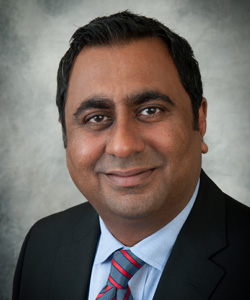Use of Telesimulation To Teach Ultrasound Guided Regional Anesthesia to Anesthetists in Ontario
Technology: e-Solutions and Telemedicine

Ahtsham U. Niazi
ahtsham.niazi@uhn.ca
416-603-5118
647-339-0387
Toronto Western Hospital, University Health Network and University of Toronto
Highlights
Telesimulation is a novel platform of teaching, which was developed by a small group of surgeons at the University of Toronto to teach the Fundamentals of Laparoscopic Surgery remotely to resource restricted countries. Telesimulation, whilst effective in teaching surgical skills, has not been used to teach Ultrasound Guided Regional Anesthesia (UGRA). The objective of this study was to examine if telesimulation could be transformed and adopted to teach UGRA remotely to anesthetists across different hospitals in Ontario, Canada. To determine whether participants obtained knowledge and skills necessary for UGRA from this teaching we assessed the training with a pre- and post-test using validated tools, consisting of a Checklist and Global Rating Scale (GRS). This was the first study to assess if telesimulation can be used to teach UGRA remotely.
Abstract
Background:
Ultrasound guided regional anesthesia (UGRA) requires acquisition of new skills. Learning requires one-on-one teaching, and can be limited by time and mentor availability. We investigate whether the skills required for UGRA can be developed and subsequently assessed remotely using a novel on-line teaching platform. This platform was developed at the University of Toronto to teach laparoscopic surgery remotely and has been termed Telesimulation.
Methods
Anesthesia Site Chiefs at ten hospitals across Ontario were sent a letter inviting their anesthesia teams to participate in an UGRA remote training program. Four to five anesthetists from each site were recruited from the first four hospitals expressing interest. Simulation models and ultrasound machines were setup at each location and connected via SkypeTM and web cameras with the Telesimulation center at our hospital. Training consisted of four on-line sessions and one off-line lecture in order to teach an ultrasound-guided supraclavicular block. Participants were evaluated before and after training by on-site and off-site assessors using a validated Checklist and Global Rating Scale (GRS).
Results
Nineteen staff anesthetists were recruited. Post-training scores were significantly higher across both assessment tools, on-site (p<0.001) and off-site training locations (p=0.003). The inter-rater reliability between on-site and remote training site ratings was good for the Checklist (ICC=0.672, 95% CI: 0.369-0.830) and excellent for the GRS (ICC=0.847, 95% CI: 0.706-0.921).
Conclusion
This study demonstrates that UGRA can be taught remotely. Future research will focus on comparing this method to on-site teaching and its application in resource-restricted countries. .

 Ahtsham U Niazi" class="rev-slidebg tp-rs-img" data-no-retina>
Ahtsham U Niazi" class="rev-slidebg tp-rs-img" data-no-retina>